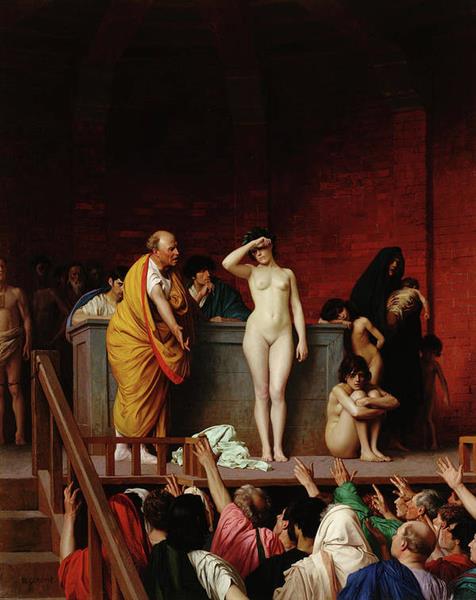Opis
Jean-Léon Gérôme's "Slave Market in Rome", painted in 1884, is a sharp message about the dynamics of power, exploitation and inequality present in classical society. Gérôme, a master of academicism and realism, uses his extraordinary technical skill to capture a scene that, although distant in time, resonates with a disturbing relevance in contemporary times.
In this composition, the central structure of the work is inhabited by a slave market, where a group of characters are surrounded by an environment that suggests bustling commerce. The color palette is sophisticated; warm, earthy tones predominate, complementing an environment from which both beauty and tragedy spring. Gérôme uses the nuances of ochre, brown and white to highlight human flesh in the sunlight, leaving a visual contrast that highlights both the liveliness of the slaves and the coldness of the commercial environment.
The characters are portrayed with a realism that is characteristic of the artist: the anxiety and restlessness visible on the figures' faces capture the essence of their situation. In the centre, a naked, dark-haired woman stands as the most obvious figure, her seemingly vacant gaze a symbol of vulnerability and dispossession. Beside her, a standing man, dressed in a toga that indicates his position of dominance, examines the slave with a mixture of desire and possession. This contrast between the opulent attire of the buyers and the nakedness of the slaves amplifies the underlying message of radical inequality between social classes.
Gérôme skillfully applies chiaroscuro, using light to emphasize the woman’s figure and create a visual focus that draws the viewer’s gaze. Perspective also plays a crucial role in the work; the angle from which the scene is presented allows the audience to become a near-voyeur of this dehumanizing transaction, including viewers in the very dynamics of slavery.
The historical context of the painting is equally fascinating, as Gérôme delved into his studies of Antiquity and the Orient, which in turn allowed him to explore themes of morality and ethics in relation to slavery, a common practice in the Roman Empire. This approach is not only a reflection of the painter's interest in history but also a critique of contemporary attitudes towards colonialism and the exploitation of people in his time.
As a piece of neoclassicism and academicism, Slave Market in Rome also reminds the viewer of earlier works by artists such as Eugène Delacroix and Jules Breton, who explored similar themes of human suffering and social inequality. However, Gérôme's work stands out for its ability to combine formal beauty with critical and profound content, making it an exploration not only of history, but of the human condition.
In conclusion, “Slave Market in Rome” is not simply a static representation of a moment in time, but a powerful commentary on the nature of humanity and its history. Each brushstroke offers a reflection that transcends the visual, provoking a discussion about pain, oppression, and hope for a future where such iniquities have no place. The work stands as a testament to the atrocities of history, and a reminder of our own humanity.
KUADROS ©, a famous painting on your wall.
Hand-made oil painting reproductions, with the quality of professional artists and the distinctive seal of KUADROS ©.
Painting reproduction service with satisfaction guarantee. If you are not completely satisfied with the replica of your painting, we will refund 100% of your money.

